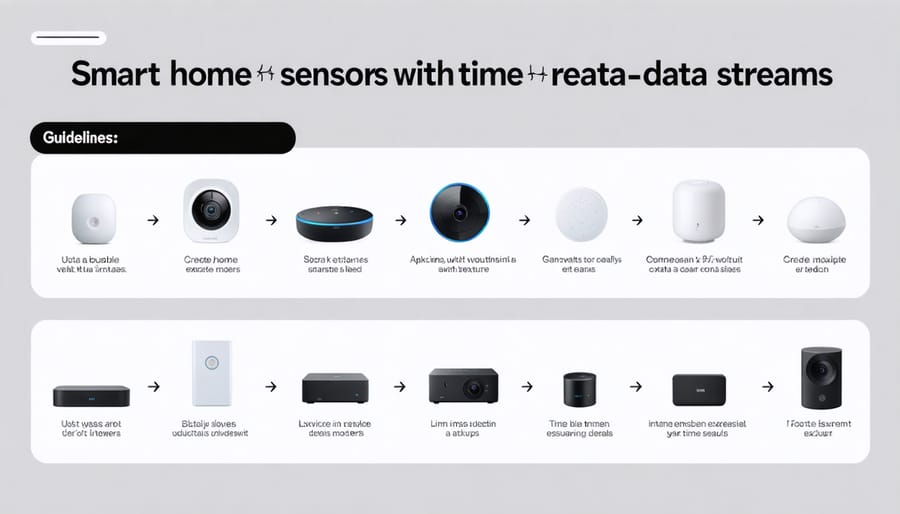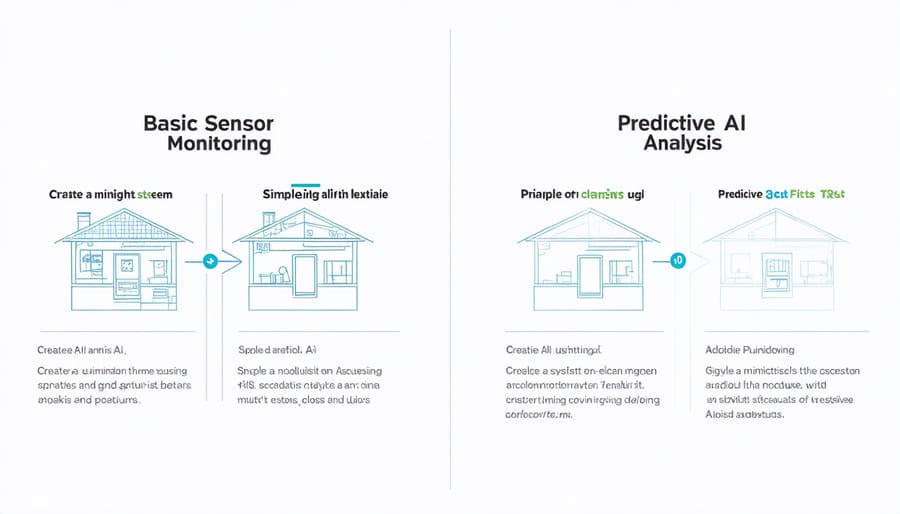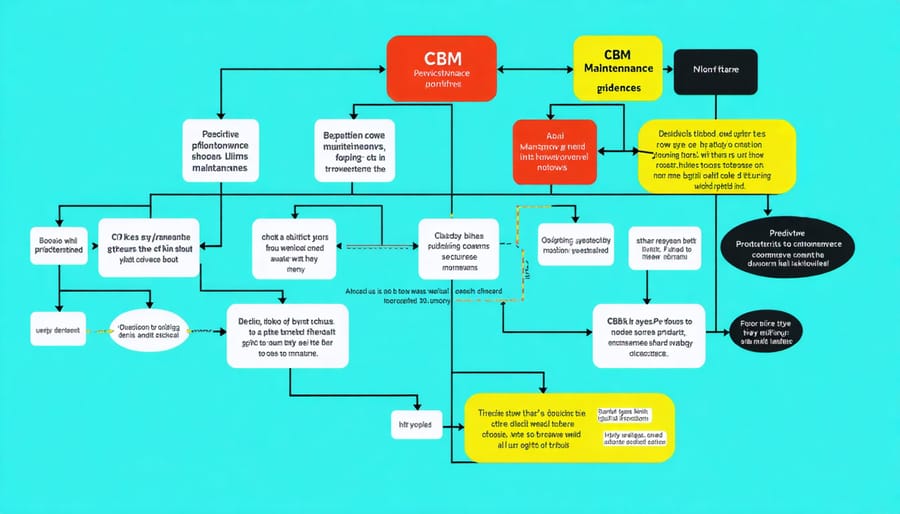Imagine walking into your home and knowing exactly when your appliances need maintenance – not just guessing or waiting for something to break. That’s the power of modern home maintenance strategies. While condition-based monitoring and predictive maintenance might sound similar, they represent two distinct approaches that can dramatically improve how you care for your home’s systems and appliances.
Condition-based monitoring is like having a doctor constantly checking your home’s vital signs, alerting you when something doesn’t look quite right. Your smart thermostat monitoring temperature fluctuations or your refrigerator tracking its cooling efficiency are perfect examples. Predictive maintenance, on the other hand, takes this a step further by using data patterns to forecast when issues might occur – like knowing your water heater will need attention in three months based on its usage patterns and age.
For homeowners embracing smart technology, understanding these approaches isn’t just about preventing breakdowns – it’s about making informed decisions that save time, money, and stress. Whether you’re managing a single smart device or an entire connected home system, knowing the difference between these maintenance strategies can help you choose the right approach for your needs.
Understanding Condition-Based Monitoring in Smart Homes
How Condition Monitoring Works
Think of condition monitoring as having a watchful friend keeping an eye on your home’s systems 24/7. Modern IoT sensors for home maintenance are like tiny observers placed throughout your house, constantly collecting information about how everything’s running.
These smart sensors measure important factors like temperature, vibration, humidity, and power usage in real-time. For example, a sensor on your HVAC system might track how smoothly the fan is running, while another monitors the temperature patterns throughout your home. This network of sensors feeds information to a central monitoring system – think of it as your home’s health dashboard.
The monitoring system processes all this data and looks for patterns or changes that might signal a developing problem. When something seems off – like your water heater using more energy than usual or your refrigerator’s temperature fluctuating – the system alerts you through your smartphone app or home hub.
What makes this setup so helpful is that it’s working quietly in the background, giving you peace of mind while taking the guesswork out of home maintenance. You’ll know exactly what’s happening with your appliances and systems without having to check them manually.
Common Applications in Smart Homes
Smart homes are becoming increasingly sophisticated, with many devices already using condition monitoring to make our lives easier. Your smart thermostat, for example, constantly monitors room temperature and humidity levels to maintain optimal comfort while maximizing energy efficiency. Similarly, smart water leak detectors keep tabs on moisture levels near pipes and appliances, alerting you before a small drip becomes a major problem.
Modern refrigerators with smart capabilities monitor their internal temperature, door-open duration, and filter conditions. Some can even track food freshness and alert you when items need replacing. Smart washing machines analyze load weight, water levels, and drum movement patterns to optimize cleaning cycles and detect potential issues before they cause breakdowns.
Security systems use condition monitoring through motion sensors, door/window contacts, and cameras to protect your home. Smart doorbells monitor visitor activity and package deliveries, while automated lighting systems track bulb life and energy usage patterns.
HVAC systems equipped with smart sensors can monitor air quality, filter conditions, and system performance, helping you maintain healthy indoor air and optimal system efficiency. These devices not only make your home more comfortable but also help prevent costly repairs through early detection of potential problems.
The Power of Predictive Maintenance
Beyond Simple Monitoring
While basic monitoring simply tells you when something’s wrong, predictive maintenance takes things to a whole new level. Think of it as having a crystal ball for your home systems – but one that actually works! Instead of just warning you about current issues, predictive maintenance uses smart technology to analyze patterns and predict potential problems before they happen.
For example, a basic monitoring system might alert you when your HVAC unit stops working. In contrast, a predictive maintenance system tracks how your HVAC performs over time, noting subtle changes in energy consumption, operating temperatures, and even unusual sounds. It then uses this data to forecast when maintenance will be needed, often weeks or months in advance.
This proactive approach means you can schedule repairs at your convenience, often preventing major breakdowns altogether. It’s like having a team of expert technicians constantly watching over your home systems, but without the hefty ongoing service fees.
The real beauty of predictive maintenance lies in its ability to save both time and money. By addressing small issues before they become big problems, you avoid emergency repair costs and extend the life of your appliances. Plus, you’ll enjoy peace of mind knowing your home systems are being monitored with advanced technology that’s working to prevent disruptions to your daily life.

Smart Home Applications
Smart homes are becoming increasingly sophisticated in how they monitor and maintain various systems. Take your HVAC system, for example. Modern HVAC predictive maintenance systems can detect subtle changes in performance before problems become noticeable, helping you avoid unexpected breakdowns and costly repairs.
Your smart water heater can now track usage patterns and alert you when efficiency drops or when components might need attention. Smart washing machines analyze vibration patterns during spin cycles to warn you about potential drum bearing issues before they fail completely.
Even seemingly simple devices like smart refrigerators have gotten in on the action. They monitor temperature fluctuations, door seal integrity, and compressor performance to help prevent food spoilage and energy waste. Smart dishwashers can detect water pressure changes that might indicate clogging or seal problems.
For the security-conscious homeowner, modern doorbell cameras and security systems use predictive algorithms to distinguish between normal activity and potential security threats. They can alert you to unusual patterns before an incident occurs.
The best part? Many of these smart systems integrate with home automation hubs, sending maintenance alerts directly to your phone and even scheduling service appointments automatically when needed. This hands-off approach to home maintenance not only saves time but also helps prevent costly emergency repairs.

Key Differences That Matter for Your Home
Cost and Value Comparison
When comparing the costs of condition-based monitoring and predictive maintenance, it’s important to look at both initial investments and long-term savings. Condition-based monitoring typically requires a lower upfront investment, as you’ll only need basic sensors and monitoring equipment. Think of it like installing a few smart thermostats or water leak detectors in your home – relatively affordable and straightforward.
Predictive maintenance, which often includes AI-powered energy management systems, usually comes with a higher initial cost. However, the long-term savings can be substantial. These systems can detect potential issues before they become major problems, potentially saving you thousands in emergency repairs.
Let’s break down the value proposition: While condition-based monitoring might cost $200-500 for basic home systems, predictive maintenance could run $1,000-2,000 for a comprehensive setup. But consider this: preventing just one major HVAC breakdown or catching a water leak early could save you $3,000-5,000 in repairs and water damage.
The real value comes from peace of mind and reduced maintenance costs over time. Predictive maintenance typically reduces unexpected breakdowns by up to 70% and extends equipment life by 20-30%. For homeowners, this means fewer emergency repair calls and more efficient operation of home systems, ultimately leading to lower utility bills and maintenance costs.
Effectiveness and Reliability
When it comes to keeping your home’s systems running smoothly, both condition-based monitoring and predictive maintenance have their strengths. Condition-based monitoring excels at catching issues as they develop, like detecting when your HVAC system starts making unusual noises or your smart thermostat shows irregular temperature patterns. This reactive-but-vigilant approach helps you address problems before they become major headaches.
Predictive maintenance, on the other hand, takes things a step further by anticipating potential issues before they even occur. For example, it might alert you that your water heater is likely to need service in the next few months based on its age, usage patterns, and performance data. This proactive approach can help you avoid unexpected breakdowns and plan repairs on your schedule.
In terms of reliability, both methods significantly outperform traditional scheduled maintenance. Condition-based monitoring reduces unnecessary repairs by 12% on average, while predictive maintenance can prevent up to 70% of equipment failures. However, predictive maintenance typically requires a bigger upfront investment in smart home technology and monitoring systems.
For most homeowners, a combination of both approaches works best. You might use predictive maintenance for critical systems like HVAC and plumbing, while applying condition-based monitoring to less complex items like appliances and lighting. This balanced strategy helps maximize the lifespan of your home’s systems while keeping maintenance costs manageable.
Making the Right Choice for Your Smart Home

When to Choose Condition Monitoring
Condition monitoring really shines in specific situations that many homeowners encounter. It’s particularly valuable for expensive home systems like HVAC units, where catching issues early can prevent costly replacements. If you have smart home devices that already collect data (like smart thermostats or water leak detectors), implementing condition monitoring is a natural fit.
Consider choosing condition monitoring when you have equipment that shows clear warning signs before failing, such as unusual noises from your washing machine or temperature fluctuations in your refrigerator. It’s also ideal for systems where continuous monitoring can prevent emergency situations – think water heaters, sump pumps, or security systems.
This approach works best when you’re comfortable with regular check-ups and want to stay actively involved in your home’s maintenance. If you enjoy keeping detailed records and prefer addressing issues as soon as they appear, rather than waiting for scheduled maintenance, condition monitoring aligns perfectly with your style. It’s especially suitable for newer homes with modern appliances that have built-in sensors or can be easily fitted with monitoring devices.
When to Opt for Predictive Maintenance
Predictive maintenance really shines when you’re dealing with expensive home systems or critical equipment that could cause major disruptions if they fail. For instance, it’s particularly valuable for your HVAC system, where a sudden breakdown could leave you without heating or cooling at the worst possible time.
Consider opting for predictive maintenance when you have smart home devices that can collect and analyze data. This approach works wonderfully with modern appliances that have built-in sensors and can communicate potential issues before they become problems. It’s also ideal if you’re managing multiple properties or have a complex home setup where unexpected failures could be especially costly.
You might also want to choose predictive maintenance if you’re tech-savvy and enjoy using data to make informed decisions. This method works best when you can regularly monitor and interpret the information your devices provide, helping you spot patterns and prevent issues before they occur.
However, remember that predictive maintenance requires an initial investment in monitoring equipment and software. The long-term savings and peace of mind often make it worthwhile for major home systems.
Implementing Your Choice
Once you’ve decided between condition-based monitoring or predictive maintenance, setting up your system is surprisingly straightforward. Start by identifying the key areas in your home that need monitoring – typically your HVAC system, major appliances, and smart home system integration components.
For condition-based monitoring, install relevant sensors on your equipment and set up a simple monitoring dashboard. Many modern appliances come with built-in sensors, making this process easier. Choose a central hub or app to collect and display your monitoring data.
If you’ve opted for predictive maintenance, you’ll need to:
1. Install smart sensors that can track performance metrics
2. Set up a data collection system
3. Establish baseline readings for your equipment
4. Configure alert thresholds
5. Create a maintenance schedule based on the data
Remember to start small and expand your system gradually. Begin with one or two critical appliances before expanding to other areas. This approach helps you learn the system while managing costs effectively.
As we’ve explored throughout this guide, both condition-based monitoring and predictive maintenance offer valuable approaches to keeping your home systems running smoothly. While condition-based monitoring helps you stay on top of current issues through real-time tracking, predictive maintenance takes things a step further by helping you prevent problems before they occur.
For most homeowners, the ideal solution is often a combination of both approaches. Start with condition-based monitoring for essential systems like your HVAC, water heater, and smart appliances. This gives you immediate insights into how your equipment is performing. Once you’re comfortable with basic monitoring, gradually incorporate predictive maintenance tools and techniques to extend the life of your investments and avoid costly repairs.
Remember, you don’t need to implement everything at once. Begin with one or two critical systems and expand your maintenance strategy as you become more familiar with the technology. Smart thermostats and water leak detectors are excellent entry points for both monitoring and prediction.
Whatever approach you choose, the key is consistency. Regular checks, whether through automated monitoring or scheduled maintenance, will help keep your home running efficiently and save you money in the long run. By staying proactive about home maintenance, you’ll enjoy greater peace of mind and fewer unexpected breakdowns.
Start small, stay consistent, and let technology work for you in protecting your home investment.
